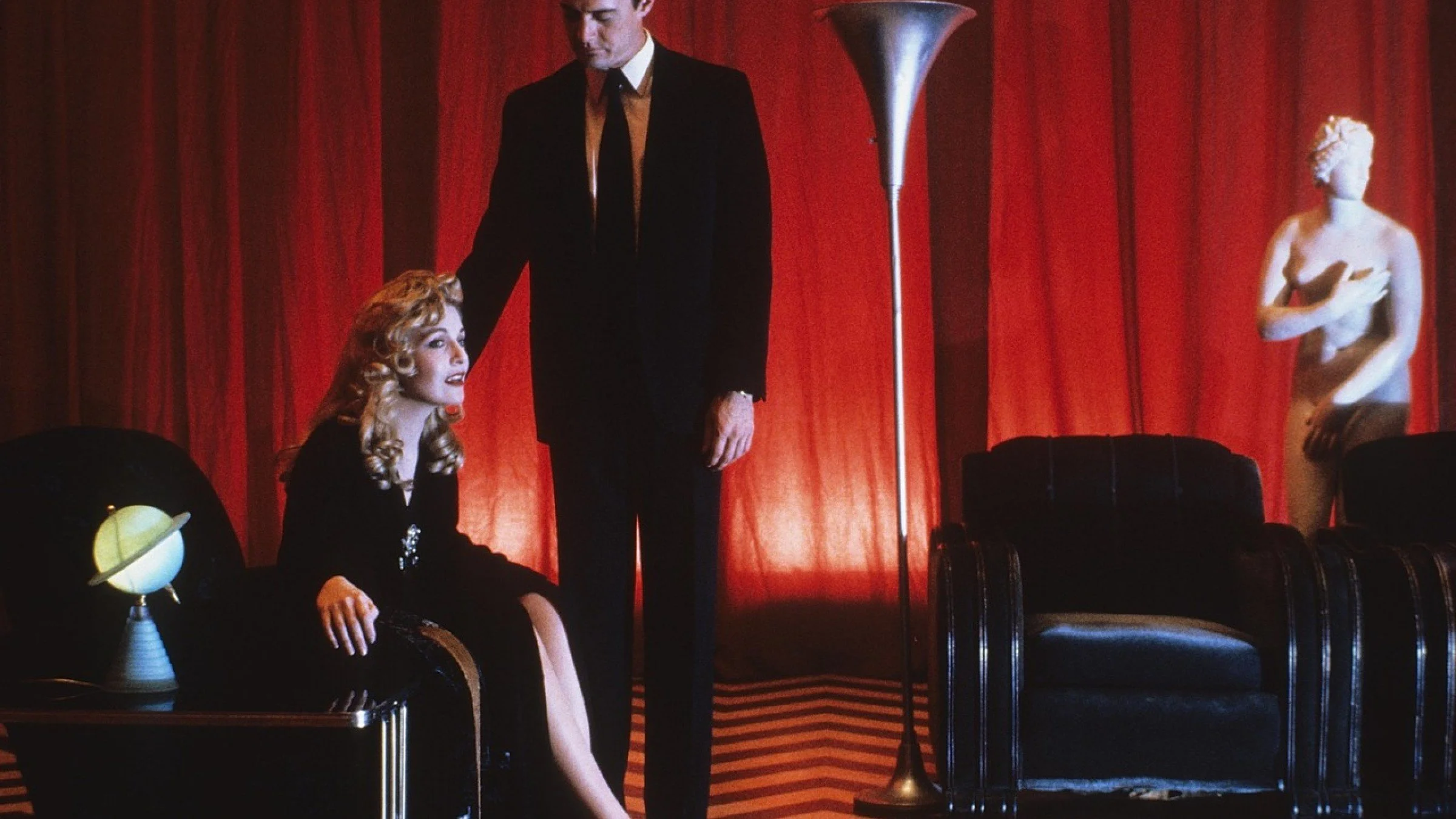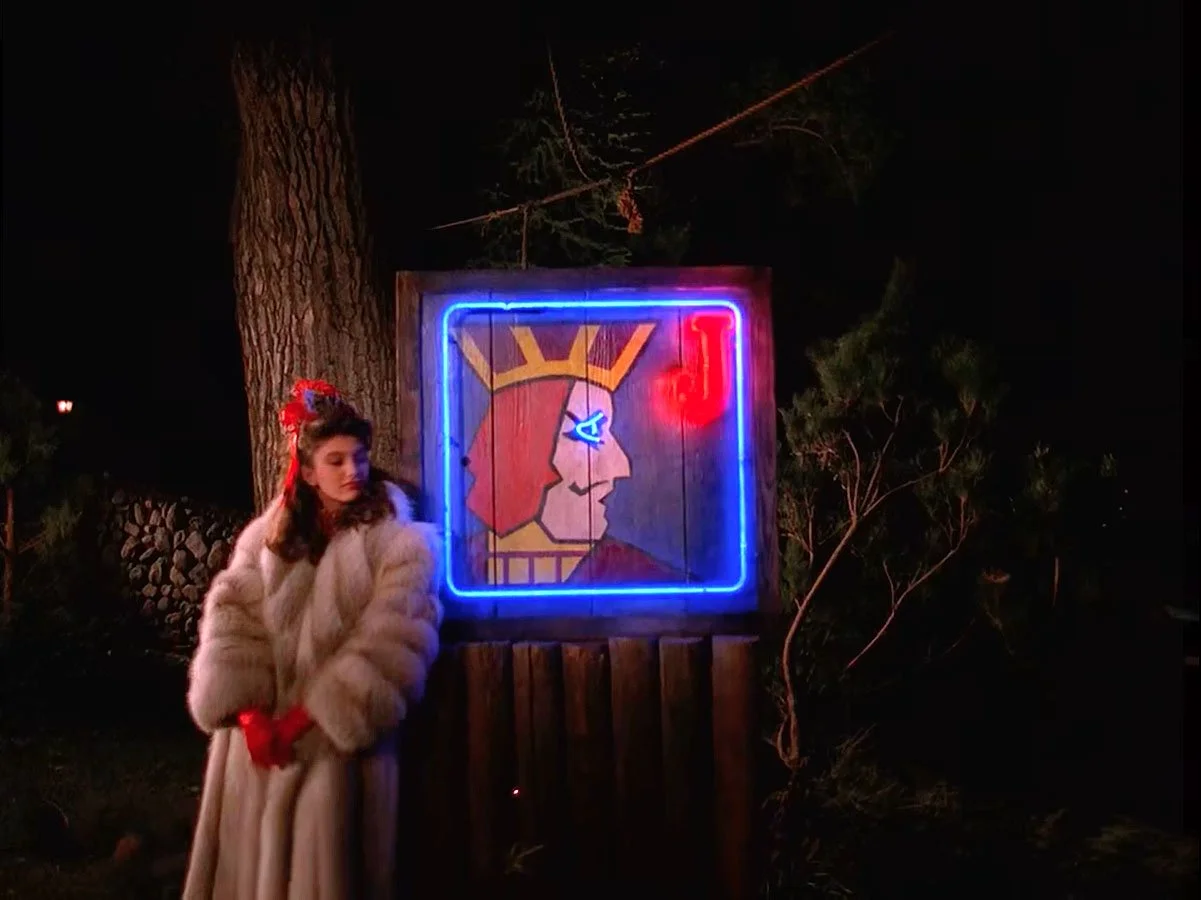The Aesthetic Influence of Twin Peaks
Words by Edsard Driessen
First hearing of Twin Peaks a little over 5 years ago while scrolling aimlessly through my Instagram timeline, I was immediately captured by the famous opening scene; the big neon ‘TWIN PEAKS’ placed over a background of rising mountains and a road that seemed to go on forever. Somehow managing to mix a feeling of modernity with that of the old, I was instantly hooked to its dreary depiction of Northwest America. Attempting to find a way to watch it proved difficult, but I finally managed to get my hands on a box-set of it over Christmas and proceeded to watch it without stopping till the final episode. The show is insanely good and well worth the watch but narrative plot aside I would have to give credit to the sheer beauty in its cinematography. With the aesthetic of Twin Peaks still finding its way into social media timelines today, what is it about a show depicting a murder-mystery that has enraptured us still to this day?
Twin Peaks opening title
Created by Mark Frost and the king of ‘weird’ television, David Lynch, the series first premiered on ABC in the summer of 1990 and follows the investigation of the murder of local ‘’IT’’ girl, Laura Palmer. Set in the fictional town of Twin Peaks, Washington, the show’s narrative draws on elements of detective fiction but its uncanny tone, supernatural elements and the melodramatic portrayal of eccentric characters work to pay homage to the American soap opera and other horror tropes. Like much of David Lynch’s work, it is distinguished by surrealist elements and a distinctly offbeat sense of humour. Receiving floods of universal acclaim by audiences and critics alike, it is considered a landmark turning point in television drama, with many citing it as one of the best television series of all time. The cultural influence of Twin Peaks cannot be more understated, with many hit TV shows to this day quoting Twin Peaks as a major influence over production. From Riverdale to Gravity Falls, even subtly presented in the music of Bastille, Twin Peaks seems to be everywhere and everything. The aesthetic composition of Twin Peaks is what distinguishes it from any other murder mystery series we may come across and its various factors work hugely well together to construct a fever dream of eclectic episodes which we frankly can’t stop watching.
Visual similarities between Twin Peaks and Riverdale
Assuming an overall dreary cinematography, Lynch works to colourfully capture the sense of rural abandonment inherit in the show’s location. Offsetting these dreary background colours with neon hues and bright dashings of reds and blues, the show is given a perfectly mysterious air from the off. A textbook example of the Lynchian ‘state of confusion’, the offsetting colour palette works to unease viewers way before we even know what the show is about. Just as Kubrick wielded vibrant shades like a directorial Picasso, Lynch used his colours as a strong storytelling device; where the use of soft red tones were used to create an unsettling sense of warmth and homeliness against the constant menace lurking in the woods. Heavily abusing vivid modernist tones against a colour palette associated with the great outdoors Lynch presented us with a perfect modern day art piece, playing on modernism while capturing the past. Lynch himself commented that ‘when the contrast is great, the elements stand out’, with this idea being perfectly seen within his colour use; going as far to oversee the network transfer of the finished programme from 35mm to ensure these tones weren’t altered. With a heavily contrasted, limited colour palette, Lynch embodied the ageless battle of good vs evil within his use of colour. This use of colour in film would influence everyone from Wes Anderson to Jean-Pierre Jeunet, and is heavily significant to constructing a surrealist fever-dream world enraptured in mystery and deceit.
Example of Twin Peaks’ rich colour palette
The filmic majesty of Twin Peaks’ set design and cinematography is a diamond in the visual lexicon of modern TV, but the vision of a small logging town possessed by forces beyond the realm of reality would never have come to fruition if it wasn’t for the prowess of the show’s cinematographers Ronald Victor Garcia and Frank Byers. Avoiding the normal application of medium shots and standard, multi-camera set-ups, Twin Peaks melded broad exterior shots with long, single-camera takes while at the same time exploiting shadows and light to signal developing doom in a fashion not unlike Albert Hitchcock himself. Focusing on unexpected camera angles, the series reuses particular peculiar shots in a fashion much like the musical leitmotif, predicting action through the placement of the camera. As seen through the low-angle staircase shots and the ceiling fan clips, Lynch created a comfortability in his presentation of the scenes. Most spectacularly seen are the depictions of those otherworldly realms such as One-Eyed Jacks, The Black Lodge and Bang-Bang Bar, where slow-motion cinematography, reversely spoken recordings and imagistic textures work to flavour the extradimensional cryptic underworlds which are placed at odds with the suburban American dream. These surrealistic dream sequences can be seen reproduced within many modern day TV offerings such as in The Sopranos where David Chase’s stellar dream sequences bear strange relation to these extra-dimensional worlds, or seen in the Lynchian limbo scenes found in True Detective.
External view of One-Eyed Jacks, in Twin Peaks
Along with colour and cinematography, the key to aestheticism in Lynch’s murder-mystery/paranormal horror thriller was the fact that almost every main character carried with them a distinct physical presence. Costume designer, Sara Markowitz married ultra 90s teenage trends with retro elegance and brilliantly bizarre modernist contours and shapes. From Audrey Horne’s iconic mixing of 50s schoolgirl and 40s femme fatale, to Nadine’s famous eye patch and cheerleader ensemble, Markowitz created a costume department where the past and present, trendy and outlandish co-existed in a town that cast surreal characters such as the Log Lady alongside everyday working characters like ‘Big’ Ed Hurley. Even in designing the costume, Twin Peaks sets to work on this concept of brooding evil amongst the everyday. But it is the championing of ‘lumberjack chic’ which carries Twin Peaks as a TV fashion bastion. Using flannels and plaid alongside denim and autumnal colours worked to give the production a surprisingly youthful feeling; by championing the everyday working uniforms of the Northwest, Lynch gave a platform to the everyday and made it look fashionably outstanding. The influence of its fashion does not have to be looked for very far, with its loose teenage aesthetic being championed in plenty of coming of age stories. From Freaks and Geeks, to my so called life and even early Friends, Twin Peaks would champion the flannel and denim combo which is still so adored to this day.
Some iconic costumes from Twin Peaks





